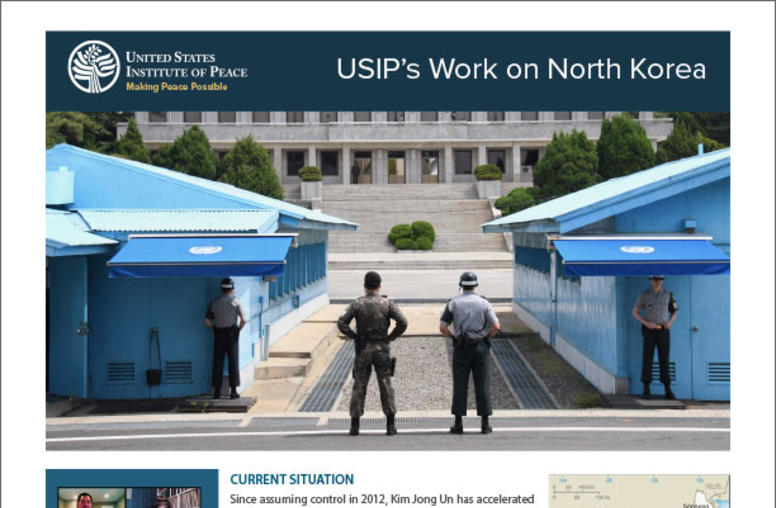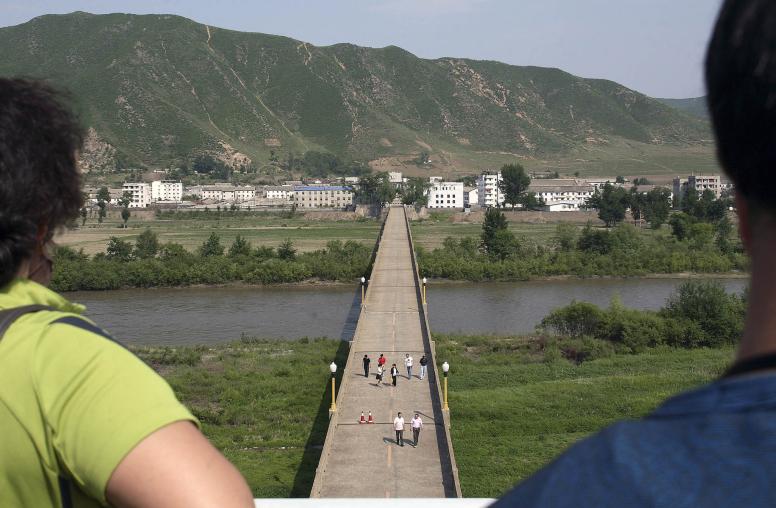How to Reduce Nuclear Risks Between the United States and North Korea
Coexistence with a nuclear-armed North Korea will require the proactive consideration of pragmatic risk reduction measures.
This essay is part of a series, Pursuing Peaceful Coexistence with North Korea, that explores how the United States and South Korea can peacefully coexist with a nuclear North Korea.
Since the collapse of the unprecedented leader-level diplomatic process between the United States and North Korea in 2019, relations between the two sides have been at a standstill. In 2021, as the Biden administration entered office, North Korean leader Kim Jong Un set into motion a wide-ranging plan for the modernization of his nuclear forces. This modernization has helped render his nuclear deterrent more credible while accentuating the risks of nuclear conflict on the Korean Peninsula. It has further cemented North Korea’s lack of intent to relinquish its nuclear weapons, which it views as the essential cornerstone of its national defense strategy.

In the absence of North Korean nuclear disarmament in the near future, the United States and South Korea should seek a new approach that seeks to manage and reduce nuclear risks through forward-leaning, practical measures.
A New Approach
Out of their self-interest in lowering the risk of nuclear conflict and seeking stability, the allies should adopt a new approach to the North Korea challenge. The new approach should address the mistrust that exists between Pyongyang, on the one hand, and Washington and Seoul, on the other. It should further seek to stabilize the Korean Peninsula such that future crises are less prone to spiral into a major conventional war that could spark deliberate or unintentional nuclear escalation. At the same time, the new approach could also be compatible with the status quo policy of maintaining robust deterrence and seeking the “complete denuclearization of the Korean Peninsula.”
In practice, North Korea may be unlikely to reciprocate interest in such proposals in the current geopolitical landscape. However, the United States and South Korea could also seek to reduce the risks of unintentional escalation, in particular, through unilateral measures, in parallel with cooperative measures to improve security on the Korean Peninsula. Ultimately, Washington and Seoul should recognize that the prospect of a nuclear-armed Pyongyang is likely to remain a long-term fixture of the strategic environment in Northeast Asia.
Mitigating North Korea’s Low Threshold for Nuclear Use through Declaratory Assurances
North Korea’s strategic predicament has led to its national defense strategy strongly privileging the role of nuclear weapons. Facing a conventionally superior, territorially contiguous nuclear-armed U.S.-South Korea alliance, Pyongyang has threatened to resort to early nuclear use both to deter conflict and, should deterrence fail, to asymmetrically escalate with the use of nuclear weapons to degrade an attack by the alliance. For these reasons, it will be difficult to push Pyongyang toward an alternative nuclear posture. However, what may be more tractable for the alliance are measures that acknowledge the most likely alliance behaviors and capabilities that incentivize early nuclear use by North Korea.
One highly tractable, short-term intervention could be declaratory assurances by the United States concerning the possibility of offensive cyberattacks on Pyongyang’s nuclear command and control systems. Since the Trump administration, the United States has pursued a comprehensive missile defeat strategy that explicitly contemplates the possibility of employing offensive cyberweapons to sever Kim from his nuclear arsenal. Due to a lack of effective strategic situational awareness capabilities, North Korea would be unable to observe any U.S. preparation for such an attack in the course of a crisis, but its leadership would fear that its ability to exercise effective control over its nuclear forces could be degraded, creating incentives to nuclear use. North Korea would also fear kinetic strikes that could degrade its command and control, but preparation for large-scale kinetic attacks by the alliance would have observable signatures. Pyongyang’s concern about these matters was crystallized in its September 2022 update to its nuclear weapons law, which announced that it would “automatically and immediately” use nuclear weapons if its command and control systems were degraded.
By forswearing deliberate non-kinetic attacks on North Korean nuclear command and control, the United States could provide an important reassurance to Pyongyang that could mitigate its incentives to resort to early nuclear use in a crisis. This would not require Washington to abjure any offensive cyber capabilities, which would be unverifiable by Pyongyang, in any case. But the current adoption of an approach that explicitly permits for non-kinetic attacks on North Korean nuclear command and control is destabilizing. Such a step could be packaged with a broader, more ambitious set of U.S. proposals seeking to limit North Korea’s nuclear capabilities — if not through a denuclearization process, then through a risk reduction process.
Inter-Korean Risk Reduction
The military postures of both North and South Korea today meet the classic definition of crisis instability: each side signals its resolve to launch preemptive strikes in the course of a war, hoping to limit damage and seek strategic and tactical advantage. For North Korea, this threat of preemption is underwritten by its nuclear weapons. For South Korea, the preemptive use of conventional ballistic and cruise missiles, backed by high-quality intelligence, is a central pillar of its “Kill Chain” strategy.
Any inter-Korean agreement, institution or process that can steer the two countries away from these preemptive attack postures will contribute substantially to improving crisis stability. Failing this, however, the two Koreas should look to the 2018 Comprehensive Military Agreement (CMA) as a template for managing the sources of instability. Though North Korea scrapped the CMA last November in response to South Korea’s partial suspension of the deal following North Korea’s launch of a military satellite, the basic logic of the agreement remains sound in addressing the scope for possible misunderstanding and incidents that could spiral into a major conventional military conflagration, which could escalate to the nuclear level.
Should political conditions improve between the two Koreas, Pyongyang and Seoul should seek to reoperationalize the CMA or a similar successor agreement that generally provides for a greater buffer between the Korean People’s Army and South Korea’s armed forces. Such an agreement need not be tied to concrete measures by Pyongyang on denuclearization, but would have the practical effect of limiting pathways to a conflict that could rapidly escalate due to the two sides’ preemptive attack postures.
Risk Reduction through Improved Diplomatic Relations
Though not a traditional focus of nuclear risk reduction on the Korean Peninsula, an improvement in diplomatic relations between the United States and North Korea can have several salutary effects on crisis stability. For instance, the prospect of a U.S. liaison office in Pyongyang, staffed by one or multiple U.S. Foreign Service officers, has been a prospect in negotiations going back to the Agreed Framework.
While a liaison office has primarily been seen for its diplomatic significance, the presence of U.S. officials in Pyongyang could attenuate any concerns North Korea may have in a serious crisis that the United States would contemplate nuclear use against at least the national capital (where Kim may be). Lowering concerns about such a strike would have the effect of mitigating the incentives that Kim might otherwise face to resort to nuclear use himself.
Since the inclusion of this proposal in the text of the Agreed Framework in 1994, the United States and North Korea have revisited it in subsequent negotiations. Ultimately, no U.S. liaison office has been set up due to a lack of progress on denuclearization, but greater flexibility on the denuclearization objective could allow Washington to take this relatively low-cost step to improve ties with Pyongyang while also mitigating nuclear risks.
Conclusions
The recommendations presented above are not uniform in their feasibility or in the extent to which they rely on existing precedent in prior diplomatic engagement with North Korea. Each, however, is premised on contributing to a short-term reduction of the risk of nuclear war on the Korean Peninsula. In parallel to longer-term thinking about denuclearization possibilities on the Korean Peninsula, U.S. and South Korean policymakers and military planners should recognize that, as a practical matter, they will continue to coexist with a nuclear-armed North Korea in the interim. Out of a shared interest with Pyongyang in lowering the risk of a nuclear conflict that neither side desires, Washington and Seoul should seek to proactively advance measures that can limit the risk of nuclear escalation in future crises.
Ankit Panda is the Stanton senior fellow in the Nuclear Policy Program at the Carnegie Endowment for International Peace.



